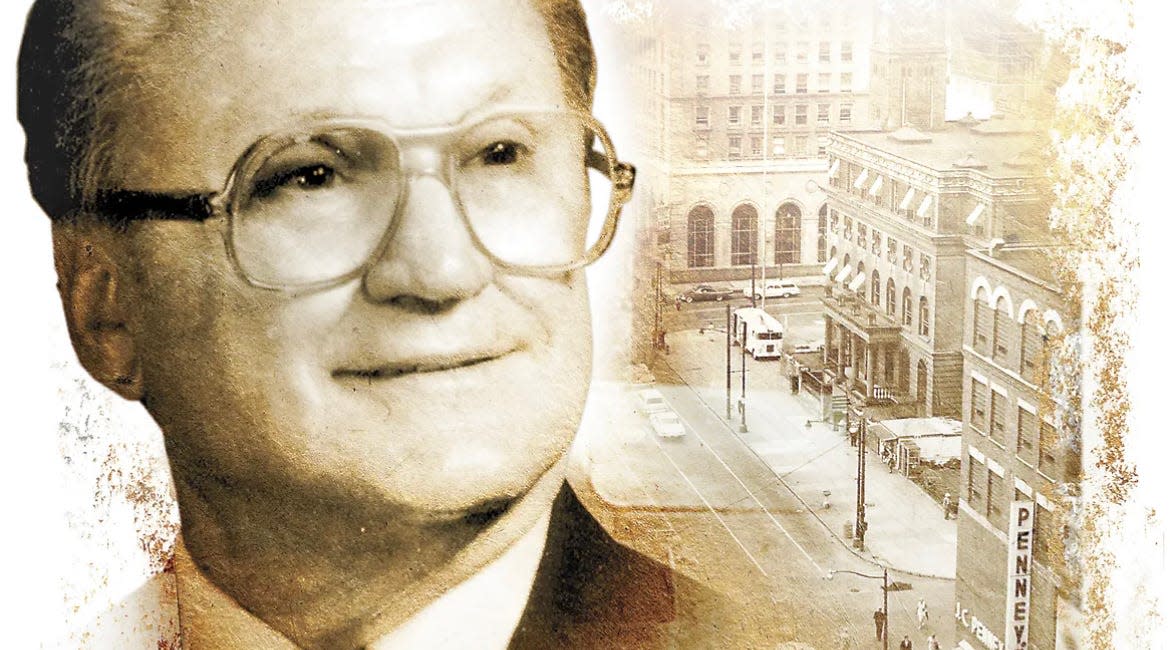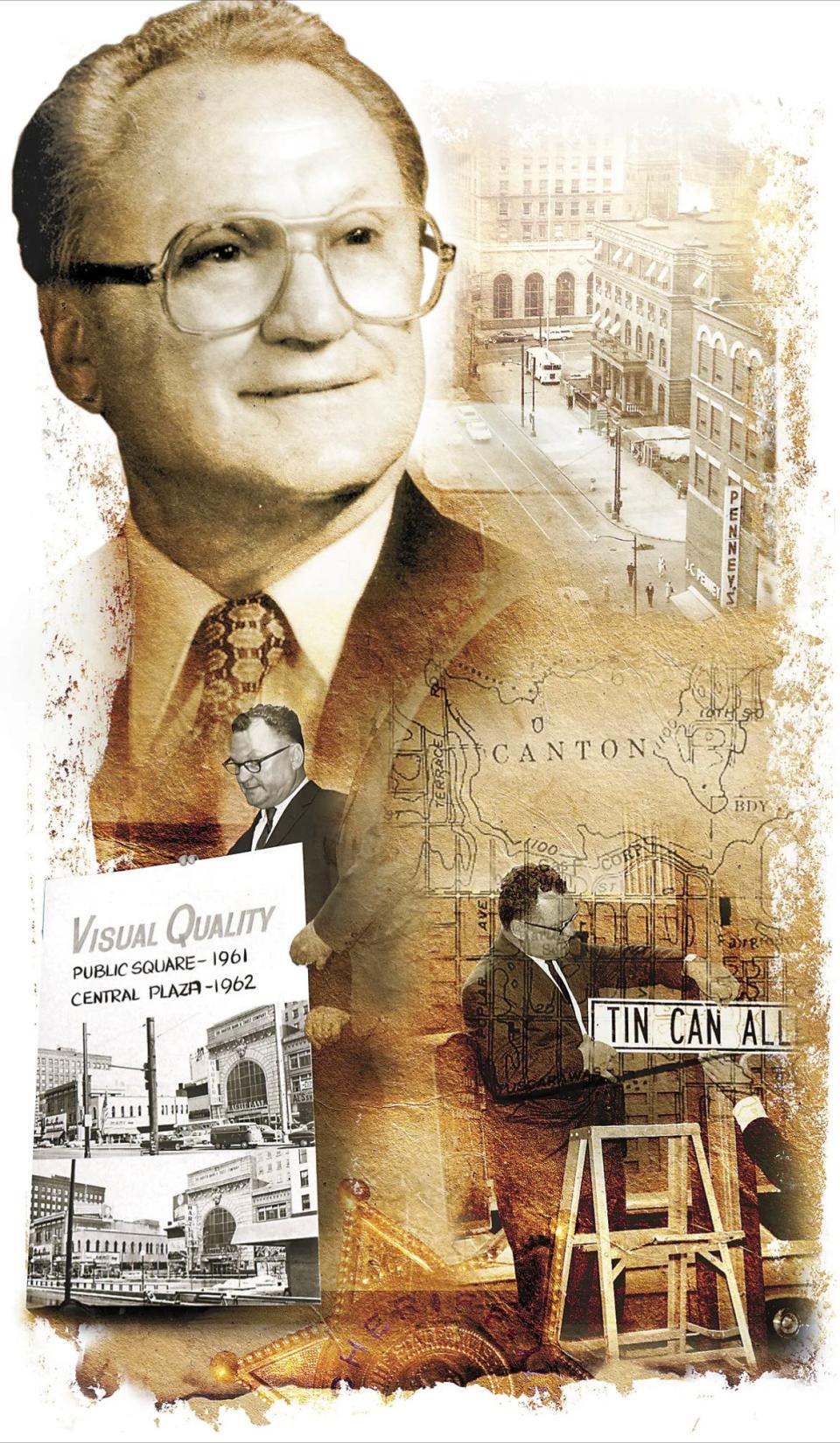The Monday After: Move to 'save' Canton's downtown raged even in 1973

Mayor Stanley A. Cmich joined a local junior high school student 50 years ago in a dramatic attempt to bring downtown Canton back to life.
One might observe that the plans of the two individuals who had an interest in revitalizing the central section of the city were as different as their ages and government experience. Still, in some senses they agreed. Both mayor and student wanted the center of Canton renewed.
"What I Think Would Help Get People Back to Canton's Downtown Section," was the title of the theme written by David Marsh, then a student in the Canton City School District.
Monday After looks at Malvern bar: Remembering 'Red' Romano and his bar in Malvern
The essay Marsh wrote and Cmich commented on at a public gathering included side streets that dead-ended into a central closed-off landscaped pedestrian mall which included fountains, sunken eating areas, and a moving sidewalk.
"There would be a moving sidewalk which people could get off and on any time they wanted," Marsh wrote. "The sidewalk would be located right down the middle of Market (Avenue)."
An underpass would route traffic on Tuscarawas Street beneath Market Avenue in a smooth flow that needed no stoplights.
On the other hand, a headline in The Canton Repository on Thursday, Sept. 20, 1973, dramatically described Mayor Cmich's plan – "CMICH: RAZE EMPTY BUILDINGS" – which he had unveiled at a luncheon program that day at Mergus Restaurant.
Preservation of Stark's past: Stark County Preservation Society's store sells the past for a cause
While Marsh's ideas were more futuristic, the mayor's intention was grounded on revitalization logic of its time.
He announced that his priority was to "remove all vacant structures that have been abandoned or are structurally unsound."
A blight on the Canton community would be removed, so better things could be built that could bring the center of the city back to life.

Early in revitalization efforts
The 1973 focus on revitalization, of course, was early in the realization that something must be done to keep a "Rust Belt" industrial city moving forward.
Earlier this summer, Repository columnist Charita Goshay provided an overview of some of the efforts that the most foresighted in the community have made in recent years to allow Canton to keep up with other Midwest cities.
"The development of Hall of Fame Village and the DoubleTree Hilton Hotel, the restoration of Thurman Munson Stadium, the preservation of the Saxton House, Renkert Building and the Onesto Hotel; reconfiguration of the Bliss Tower, the Hercules Building and the George D. Harter Bank; and a resurgence in downtown entertainment venues," Goshay wrote in a column published in the newspaper on July 16, "are the kinds of sparks needed in order for Canton to stay relevant and competitive with surrounding communities, which are offering amenities, and building entertainment venues as fast as they can."
In 1973, however, Cmich and others with eyes on how the city was changing were focusing on removing an ugliness that had begun to show itself on Canton's central streets.
In the news in Canton's past: Looking back at life 200 years ago
Repository reporter Robert S. George covered the Mergus Restaurant luncheon – attended by businessmen, government officials and owners of downtown buildings – at which Cmich declared his intentions to appoint Safety Director Frank Burnosky to head up a team of building inspectors that also included representatives of the city's Fire Prevention Bureau, Building Department and Health Department.
Cmich explained that "those buildings which prove to be 'safety or health hazards' or which have 'blighting influence and discourage development' will be removed," wrote George.
Owners of unsafe structures, or those which had "dirty and unkept fronts" would be contacted "to work out, in a cooperative spirt, an orderly process of removal," Cmich said at the luncheon.
"Vacant, dirty and unkept fronts of structures have the same negative affect on encouragement of development of the area as do abandoned, unsafe structures," the mayor said.
Revitalization already underway
Cmich noted in his talk that the renewal of Canton's downtown section already had begun.
"He also announced that first steps in the revitalization have been taken by Harter Bank & Trust Co., which has purchased two downtown properties and will acquire a third, and by an undisclosed company, which purchased Belden Hotel," wrote George.
An editorial in the Repository a few days later praised Harter Bank's actions, as well as other relatively recent steps taken by local businesses and financial institutions.
"Since 1960, a total of $109,944,511 has been expended for improvements in the downtown area and financial institutions have been very much in the forefront," noted the editorial, published Sept. 23, 1973.
More than three dozen "private and public institutions" had erected new buildings or undertaken major renovations and expansions, the editorial noted.
"It helped imensely to set the tone for positive action that is the theme of the undertaking by the city, the Greater Canton Chamber of Commerce and the Central Canton Development Association."
A second editorial the same day added force to the argument that the revitalization of downtown Canton was needed, while at the same time echoing the mayor's belief that the situation was not as bad as it seemed.
"It is a subject that has been bandied about for years without any centralized attack on the problem," explained the editorial. "It behooves all citizens to understand what is being done and to provide the effort with maximum support."
Still, as the mayor pointed out in his luncheon words, "downtown Canton is not in as dire shape as it seems," said the editorial.
"There are 748 commercial and retail businesses in operation in the section and 39 vacant properties," said the editorial. "Percentagewise, the number of vacancies may not be high but the unused stores and buildings create a bad impression."
The editorial espoused a revitalization plan that through subsequent years has become a focus of a center-of-the-city rebirth.
"Revitalization of downtown Canton will not be promoted as a full-scale revival of retail business in the area, and properly so," said the editorial. "There will be need of attractive specialty shops ... but the large department stores which depend for survival upon heavy and continuing customer traffric will not reappear in the central city.
"Primarily, the emphasis will be on government and professional offices, financial institutions, utility companies, and other service firms and housing, especially for the elderly."
Reach Gary at gary.brown.rep@gmail.com. On Twitter: @gbrownREP.
This article originally appeared on The Alliance Review: The Monday After: Move to 'save' Canton's downtown raged even in 1973

